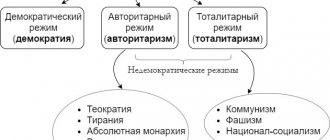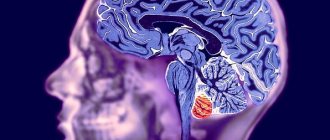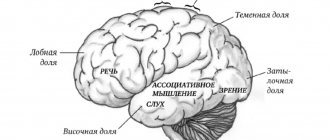Doctors at the Leto Mental Health Center observe various types of disorders. Among them is explosive psychopathy - a personality disorder that is manifested by ardor, short temper, conflict behavior and even aggressiveness. Such people literally suffer from themselves - they are aware of the inconvenience that arises because of them for those around them. If you find the same symptoms in your loved ones, call 8(969)060-93-93 , we will help you get rid of the pathology, and your loved ones will regain the joy of life.
Total information
The word “explosive” is borrowed from the English language - in translation “explosion” (pronounced “explosion”) means “explosion”. The character of the sufferer can really be called “explosive” - unpleasant symptoms arise suddenly. This is one of the most common types of psychopathy - a disorder, the essence of which psychologists convey in three words:
- disinhibition;
- courage;
- meanness.
It happens that you were suddenly attacked by a saleswoman at the market, or an opponent “drove” over you on social networks, although it seemed that you did nothing to provoke such a pronounced reaction. It is possible that these individuals suffer from the described disease. Thanks to many years of experience, our specialists are able to discern this pathology.
The aggression of people who have been diagnosed with this form of psycho-emotional disorders is forced to be tolerated by their environment. If they accidentally ended up in someone’s personal space, that’s not so bad; further communication can be avoided so as not to repeat the sad experience. But such individuals suffer from family members and other relatives, friends, work colleagues, neighbors - it is impossible or difficult for these categories to simply stop communicating due to life circumstances.
Causes
The immediate cause of explosive psychopathy is the characteristics of the central nervous system:
- congenital;
- acquired.
In the latter case, such “acquisition” is usually observed at an early age. Several forms of pathology have been identified:
- nuclear - appears against the background of human physiological characteristics;
- marginal - develops due to unfavorable external influences.
The causes of the nuclear form are:
- unfavorable heredity - usually this form of behavior is observed in other family members;
- disruption of pregnancy in the individual's mother;
- complex (often pathological) childbirth, during which it appeared;
- developmental disorders at an early age.
The causes of the marginal form of explosive psychopathy are:
- lack of proper education;
- regular conflicts between father and mother in front of the child;
- childhood psychotrauma;
- chronic long-term illnesses;
- traumatic brain injuries and their consequences.
To help such patients, we carefully study each case individually and take into account all the nuances. Our doctors believe that important causes of regional explosive psychopathy are also violation of the personal space of a child or adolescent, persecution by others, regular humiliation in the family and society, extremely gross suppression of the individual, and indifferent attitude towards minors. Although the disorder often arose in the opposite situation - in the case when the child was adored, indulged in every possible way, and did not prohibit any actions.
Typically, explosive psychopathy is identified with such features as:
- extroverted character type;
- explosive temperament;
- lack of self-control;
- stubbornness.
The sooner the atmosphere in which a child lives is normalized, the greater the chance that he will not suffer from explosive psychopathy. If, as he grows up, he is surrounded by restrained, wise, calm people, this is a favorable factor; thanks to it, an explosive child will grow into a person who will take care of the moral comfort of those around him.
The marginal form is easier and faster to correct, and we have extensive experience in its implementation. Disorders of behavioral reactions are less pronounced, the patient is more socially labile - ready to control his behavior and work on himself. The nuclear form has a less favorable prognosis.
PsyAndNeuro.ru
We are publishing the following descriptions of changes to the ICD-11 chapter on mental, behavioral and neurodevelopmental disorders. This part describes changes in the following groups: dissociative disorders, eating and feeding disorders, personality disorders, desire disorders, neurocognitive disorders, etc.
The February issue of World Psychiatry Journal, which described the main changes in ICD-11, was translated by the Council of Young Scientists of the Russian Society of Psychiatrists. Changes in other chapters can be found by following the link.
Dissociative disorders
The ICD-11 group of dissociative disorders corresponds to the dissociative (conversion) disorders in ICD-10, but has been significantly reorganized and simplified to reflect recent empirical evidence and to improve clinical utility. The reference to the term "conversion" has been removed from the group name. Dissociative disorder with neurological symptoms in ICD-11 is conceptually consistent with dissociative movement and sensation disorder in ICD-10, but is presented as a single disorder with twelve subtypes distinguished based on predominant neurological symptoms (visual impairment, non-epileptic seizures, speech impairment, paralysis or weakness etc.).
In ICD-11, dissociative amnesia includes dissociative fugue as a qualifying parameter, while in ICD-10 it was distinguished as a separate disorder. ICD-11 has divided trance and possession disorder (ICD10) into two different diagnoses: trance disorder and possession disorder. This division reflects the hallmark of possession disorder, in which, during possession, the habitual sense of self-identity is replaced by a sense of an external personality invoked by the influence of some spirit, force, deity, or other spiritual entity. Additionally, obsession disorder may describe a wider range of behavior, whereas trance disorder is usually limited to a small repertoire of simple actions.
Dissociative identity disorder in ICD-11 follows the ICD-10 concept of multiple personality disorder and has been renamed to be consistent with the nomenclature currently used for clinical and research purposes. ICD-11 also introduced partial dissociative identity disorder, reflecting the fact that ICD-10 is dominated by unspecified dissociative disorders in which non-dominant personality states periodically do not fully assume control of the individual's consciousness and functioning. Depersonalization and derealization disorder, localized in ICD-10 in the group of other neurotic disorders, was moved to the dissociative group in ICD-11.
Eating and feeding disorders
The ICD-11 grouping of eating and feeding disorders combines the ICD-10 groups of eating disorders and childhood feeding disorders, recognizing the interrelationship of these disorders across the lifespan, and also reflecting evidence that these disorders may apply to individuals over a wider age range.
ICD-11 provides an updated understanding of anorexia nervosa and bulimia nervosa and includes the latest data, eliminating the need for the “atypical” category from ICD-10. It also includes new types of binge eating disorders, which are based on empirical support for validity and clinical utility, and ARFID (avoidant or restrictive eating disorder), which includes the ICD-10 diagnosis of feeding disorder of infancy and childhood.
Anorexia nervosa in ICD-11 removes the ICD-10 requirement for the presence of a widespread endocrine disorder, since evidence suggests that this does not occur in all cases and, even if present, is a consequence of low body weight rather than a characteristic feature of the disorder . In addition, cases without endocrine disorders were a common reason for the diagnosis of atypical anorexia. The threshold for low body weight in ICD-11 has been raised from 17.5 kg/m² to 18 kg/m², but the recommendations take into account situations in which body mass index may not adequately reflect clinical deterioration (for example, sudden weight loss in the context of other features of the disorder ). Anorexia nervosa does not require “fat phobia” as in ICD-10 to provide a full range of culturally diverse rationales for food refusal and body image preoccupation.
The criteria are designed to characterize the severity of underweight, recognizing that a significantly reduced body mass index is associated with an increased risk of morbidity and mortality. The criteria allow us to describe patterns of behavior (restrictive and purifying).
ICD-11 bulimia nervosa can be diagnosed regardless of a person's current weight, as long as the body mass index is not so low as to meet the criteria for anorexia nervosa. In place of the minimum frequency criterion for binge eating, which is not supported by evidence, ICD-11 provides more flexible guidance. The diagnosis of bulimia nervosa does not require "objective" binge eating and can be diagnosed based on "subjective" binge eating, in which the person eats more or differently than usual and experiences a loss of control over eating accompanied by distress, regardless of the amount of food actually eaten . This change is expected to reduce the number of unspecified eating and feeding disorder diagnoses.
Elimination disorders
The term "inorganic" has been removed from the ICD-11 group of elimination disorders, which include enuresis and encopresis. These disorders are differentiated from those that may be better explained by another health condition or physiological effects of substances.
Disorders related to bodily self-awareness and bodily discomfort
The group of disorders associated with bodily self-awareness and bodily discomfort in ICD-11 contains two disorders: bodily discomfort and dysphoria of the integrity of the perception of one’s own body. Bodily discomfort disorder ICD-11 replaces the somatoform disorders of ICD-10, and also includes the concept of neurasthenia from the ICD. Hypochondriasis (ICD-10) is not included in this group, but is in the OCRD group. Body discomfort disorder is characterized by the presence of bodily symptoms that cause pain to the person and an excessive focus on the symptoms, which may manifest itself in repeated contact with health care professionals.
Disorders can vary in severity and are categorized accordingly (mild, moderate or severe) depending on the impact on functioning. It is important to note that body discomfort disorder is defined according to the presence of important features such as distress and excessive thoughts and behaviors, rather than based on the lack of medical explanations for bothersome symptoms, as with ICD-10 somatoform disorders. ICD-11 introduced a new diagnosis that is part of this group - dysphoria of the integrity of perception of one’s own body.
Substance use and addictive behavior disorders
The ICD-11 group of substance use and addictive behavior disorders covers disorders that develop as a result of the use of psychoactive substances, including drugs, as well as addictive behavior disorders that develop as a result of certain repetitive behaviors with reward and reinforcement. The organization of ICD-11 for substance use disorders is consistent with the approach of ICD-10, which classifies clinical syndromes according to classes of substances.
At the same time, the list of substances in ICD-11 has been expanded to reflect the current availability and use of substances. Each substance or class of substance may be associated with mutually exclusive primary clinical syndromes: a single harmful substance use or harmful substance use pattern that is a refinement of the ICD-10 diagnosis of harmful use, and substance dependence. Substance intoxication and withdrawal may be diagnosed on the basis of clinical manifestations or asymptomatic substances (as a reason for presentation to a health care provider when the pattern of use or dependence cannot be determined). Given the extremely high global burden of disease associated with substance use, this group has been revised to optimally provide health information that will be useful in a variety of contexts, including accurate monitoring and reporting, and to be useful for both prevention and for treatment.
The addition of a single episode of harmful substance use to ICD-11 provides an opportunity for early intervention and prevention of escalation of use and harm, and diagnoses of harmful substance use and drug dependence suggest the need for increasingly intensive interventions. ICD-11 expands the concept of health harm resulting from substance use to include harm to the health of others, which can include either physical harm (for example, from drunk driving) or psychological harm (for example, the development of PTSD after a car accident ).
ICD-11 includes substance-induced mental disorders as syndromes characterized by clinically significant mental or behavioral symptoms similar to those of other mental disorders, but resulting from substance use. Substance use disorders may be associated with substance intoxication or withdrawal, but the intensity or duration of symptoms significantly exceeds those characteristic of substance intoxication or withdrawal. ICD-11 also includes categories of hazardous substance use that are not classified as mental disorders but are found in the chapter “Factors influencing health status or contact with health services.”
These categories may be used when the pattern of substance use increases the risk of harmful effects on the physical or mental health of the user or others to such an extent that it requires the attention and advice of health care providers, but no obvious harm has yet occurred. They are intended to communicate opportunities for early and brief intervention, particularly in primary care settings. The ICD-11 section on addictive behavior disorders includes two diagnostic categories: gambling disorder (pathological gambling in ICD-10) and gambling disorder, which was recently introduced.
In ICD-10, pathological gambling was classified as a disorder of habits and impulses. However, recent evidence points to important phenomenological similarities between addictive behavior disorders and substance use disorders, including their higher co-occurrence rates as well as a common pattern of being initially pleasurable and then progressing to loss of pleasure and require more active use. In addition, substance use disorders and addictive behavior disorders appear to share similar neurobiology, particularly activation and neuroadaptation in neural circuits involved in reward and motivation.
Impulse control disorders
Impulse control disorders in ICD-11 are characterized by a repeated failure to resist a strong impulse, urge, or urge to perform an act that brings satisfaction to the individual, at least in the short term, despite long-term harm to both the subject and others. This group includes pyromania and kleptomania, which were classified in the ICD-10 as habit and impulse disorders. ICD-11 added intermittent explosive disorder to the group of impulse control disorders and renamed excessive sexual desire (ICD-10) to compulsive sexual behavior disorder.
Defiant and dissocial behavior disorders
In ICD-11, the group of defiant and dissocial behavior disorders replaced the ICD-10 behavior disorders. The new term better reflects the full spectrum of severity of behavior and phenomenology observed in the two conditions included in this group: oppositional defiant disorder and conduct-dissocial disorder. An important change made in ICD-11 is that both disorders can be diagnosed throughout life, whereas ICD-10 interprets them as childhood disorders. In addition, ICD-11 introduces clarifying categories that characterize subtypes of defiant and dissocial behavior disorders, intended to improve clinical utility, for example, prognostically.
Oppositional defiant disorder ICD-11 is similar to its equivalent ICD-10 category. However, the qualifying category “with chronic irritability and anger” has been added to characterize these manifestations of the disorder as having a predominant, persistent irritable mood or anger. This form has been shown to significantly increase the risk of developing depression and anxiety. The ICD-11 approach to the manifestations of oppositional defiant disorder is consistent with current evidence and differs from the approach of DSM-5, which introduced the new defiant mood dysregulation disorder.
Conduct disorder in ICD-11 combines the three separate conduct disorder diagnoses classified in ICD-10 (family-limited, unsocialized, and socialized). ICD-11 recognizes that challenging behavior and dissocial disorders are often associated with problematic psychosocial environments and psychosocial risk factors such as peer rejection, deviant peer group influence, and parental mental disorder. Clinically significant differences between childhood and adolescent onset of a disorder can be indicated using qualifying categories because there is evidence that earlier onset is associated with more severe pathology and a worse course of the disorder.
A qualifying category for limited prosocial emotions can be used in both defiant and dissocial disorders. In the context of a diagnosis of oppositional defiant disorder, these manifestations are associated with more persistent and severe oppositional behavior. And in the context of dissocial conduct disorder, limited prosocial emotions are associated with a tendency toward more severe, aggressive, and persistent antisocial behavior.
Personality disorders
Problems with the ICD-10 classification of ten specific personality disorders included significant underdiagnosis regarding their prevalence among people with other mental disorders, the fact that only two of the specific personality disorders (emotionally labile personality disorder, borderline personality disorder, and dissocial personality disorder) were reported with any frequency in public databases, and that co-occurrence rates were extremely high, the majority of people with severe disorders met criteria for multiple personality disorders.
The ICD-11 CDDG asks the clinician to first determine whether the clinical picture meets the general diagnostic criteria for a personality disorder. The physician then determines the degree of disorder (mild, moderate or severe) based on: a) the degree and prevalence of disturbances in the functioning of aspects of the personality (stability and consistency of personality, self-esteem, adequacy of self-perception, ability to self-control); b) the degree and prevalence of interpersonal dysfunctions (understanding others' points of view, developing and maintaining close relationships, conflict management) in different contexts and relationships; c) prevalence, severity and chronicity of emotional, cognitive and behavioral manifestations of personality dysfunction; d) the extent to which these patterns are associated with distress or psychosocial impairment. Personality disorders are then further described with characteristic maladaptive personality traits.
They include five domains: negative affectivity (the tendency to experience a wide range of negative emotions); detachment (the tendency to maintain social and interpersonal distance from others); dissociality (ignoring the rights and feelings of other people, including egocentrism and lack of empathy); disinhibition (the tendency to act impulsively in response to immediate internal or external stimuli without considering longer-term consequences); anacastism (a narrow emphasis on a standard of perfection, right and wrong, and on ensuring that one's own and others' behavior fully conforms to these standards). As part of the diagnosis, multiple domains may be assigned simultaneously that are considered salient and contribute to the personality disorder and its severity. In addition, an optional qualifying category is given to be used for the "template boundary". This category is intended to provide continuity of care during the transition from ICD-10 to ICD-11 and may enhance clinical utility by making it easier to identify people who may be responsive to specific psychotherapeutic treatments.
Additional research will be required to determine whether it provides information that differs from that presented in the personality trait domains. ICD-11 also includes a category of personality difficulties that are not considered mental disorders but are listed under interpersonal problems in the chapter “Factors Affecting Health Status or Contacts with Health Services.” Personality difficulties are defined as significant personality characteristics that may affect treatment or health care services but do not exceed the level of severity to warrant a diagnosis of a personality disorder. A more detailed analysis can be read at the link.
Desire disorders
The group of desire disorders in ICD-11 has been introduced to replace the group of disorders of sexual preference in ICD-10, which corresponds to modern terminology used in scientific and clinical settings. The main feature of desire disorders is that they involve patterns of sexual arousal that are directed toward the non-consent of others.
Desire disorders in ICD-11 include exhibitionistic, voyeuristic and pedophilic disorders. New categories of urge disorders include compulsory sadistic sexual disorder, frottage disorder, and other paraphilic disorder involving nonconsenting individuals. The new category of other paraphilic disorders includes behavior alone or with the consent of included individuals who have consented to sexual thoughts, fantasies, urges, or behavior involving significant distress (threats of refusal or fear of refusal are not included), or pose a direct risk of injury or death ( for example, asphyxophilia). ICD-11 distinguishes between conditions that are relevant to public health and clinical psychopathology and conditions that simply reflect private behavior. For this reason, the ICD-10 categories of sadomasochism, fetishism, and fetishistic transvestism have been eliminated.
Factitious disorders
ICD-11 introduces a new group of factitious disorders that includes self-imposed factitious disorder and factitious disorder delegated to another. This group is conceptually equivalent to the ICD-10 diagnosis of intentionally causing or feigning symptoms, or a physical or psychological disability (false impairment), but is expanded to include a clinical situation in which an individual feigns, falsifies, or intentionally stimulates or aggravates psychological or behavioral symptoms and symptoms in another person (usually a child). These behaviors are not motivated by obvious external rewards or incentives, and on this basis they are distinguished from malingering, which is not classified as a mental, behavioral or neurodevelopmental disorder, but rather falls under the chapter “Factors influencing health status or contact with health services.” "
Neurocognitive disorders
Neurocognitive disorders in ICD-11 are acquired conditions characterized by a primary clinical deficit in cognitive functioning, and include most of the conditions that were classified as organic, including symptomatic, mental disorders in ICD-10. Thus, the group includes delirium, mild neurocognitive disorder (called mild cognitive impairment in ICD-10), amnestic disorder, and dementia. Delirium and amnestic disorder can be classified as being caused by another medical condition classified elsewhere, caused by a substance or drug, or several etiological factors. Dementia can be classified as mild, moderate or severe.
Syndromic characteristics of dementia associated with different etiologies (eg, dementia due to Alzheimer's disease, dementia due to human immunodeficiency virus) are classified and described in the chapter on mental, behavioral and neurodevelopmental disorders, while the underlying etiologies are classified using categories from the chapter on diseases of the nervous system or other sections of the ICD, as appropriate. Mild neurocognitive disorder may also be identified in conjunction with an etiological diagnosis, reflecting improved methods for detecting early cognitive decline, providing an opportunity to provide treatment to delay disease progression. Thus, ICD-11 clearly describes the cognitive, behavioral and emotional components of neurocognitive disorders, as well as the causes that underlie them.
Translation into Russian was organized by the Council of Young Scientists of the Russian Society of Psychiatrists with the support of the World Psychiatric Association.
Support us by subscribing to Patreon
Translation: Pikirenya V.I. (Minsk)
Editor: Ph.D. Reznikov M.K. (Voronezh)
Source: Reed GM, First MB, Kogan CS, et al. Innovations and changes in the ICD-11 classification of mental, behavioral and neurodevelopmental disorders. World Psychiatry
. 2019;18(1):3–19. doi:10.1002/wps.20611
Signs
The basic symptom of the described disorder is outbursts of anger. They:
- repetitive;
- uncontrolled;
- provoked by the slightest psycho-emotional stimuli.
Based on careful observation of patients, doctors at the Leto clinic believe that the effect of such irritants is just a formal reason for the appearance of rage; in fact, it can arise “out of nothing.” Typically, attacks of explosive psychopathy are preceded by banal everyday and work troubles:
- breakfast untimely prepared by the wife;
- a child's poor grade at school;
- subordinate being late for work;
- crowding on public transport and so on.
Ordinary ordinary situations cause aggression, projected onto others. The person himself points out what turned him on. But often there is no visible reason - the eruption of such an emotional “volcano” is possible against the background of complete well-being, in the absence of any provocative factors.
His relationships depend on how much the patient can control outbursts of anger:
- family;
- friendly;
- workers;
- social.
Many people find a personal way to calm themselves as soon as the first signs of an attack appear, and thanks to this they save their families, jobs, and so on. Others are unable to do this - not due to a lack of desire, but due to physiological deviations in the activity of the brain, due to which they are not able to adapt in society. Therefore they:
- often get married and divorced;
- change jobs regularly;
- can't make friends.
Such individuals with explosive psychopathy are often diagnosed with somatic diseases that arise from stress. This:
- peptic ulcer of the stomach and duodenum - the formation of one or more deep defects in the walls of these organs;
- myocardial infarction - necrosis of a fragment of the heart muscle, which develops against the background of a violation of its blood supply;
- Diabetes mellitus is a failure of carbohydrate metabolism due to a lack of the hormone insulin.
Therefore, if necessary, we involve related specialists if our patients need their consultation. We have huge long-term collegial connections with other clinics, and we treat not the disease, but the patient - this is precisely the postulate that is one of the most important in medicine.
Signs and symptoms
Below are signs and symptoms of impulse control disorders.
Oppositional defiant disorder
People with this disorder:
- become irritable
- they have challenging behavior, which often stems from the person being asked to do chores or obey rules
Intermittent explosive disorder
People with this disorder:
- easily disappointed
- often well-mannered outside of explosive outbursts
- repeated verbal or physical outbursts may result in injury or physical harm
Behavioral disorders
Signs and symptoms of conduct disorder include:
- destruction of property
- constant lies
- illegal and criminal activities
- seemingly lack of emotion
Kleptomania
Signs and symptoms of kleptomania include:
- stealing items they don't need or items that are worth little or nothing
- feeling compelled to steal
- feeling guilty or depressed after theft
- feeling of relief after theft
Pyromania
Signs and symptoms of pyromania include:
- tension just before lighting the fire
- feeling compelled to start a fire
- lighting a fire is not a response to anger or revenge
Features of the flow
Symptoms of explosive psychopathy are observed already in childhood. The child is usually disobedient, unyielding, stubborn, and often conflicts with peers. Often he even uses physical force to defend his interests.
Patients in adulthood may be aware that they have abnormalities, but are unable to control them. They do not know how to regulate conflicts of varying degrees of severity, even if this is fraught with stress for themselves.
Explosive psychopathy is not a character trait, but a deviation. It must be combated, as it can cause serious administrative and criminal violations. Such people are capable of “getting excited” for literally a trifle.
Types
There are five disorders that fall under the umbrella of impulse control disorder.
Oppositional defiant disorder (ODD)
Oppositional defiant disorder is usually a conduct disorder of childhood. Those with this condition find it difficult to control their emotions and behavior. About 2-11% of children have this disorder, and it is more common in preschool-aged boys.
In children with ODD, symptoms usually begin to appear between the ages of 5 and 10 years, and may disappear as they get older.
Intermittent explosive disorder
Intermittent explosive disorder is more common in late childhood or adolescence. People with this condition have brief moments of anger and aggression that seem out of proportion to the cause. The cause may not be apparent to anyone except the person with intermittent explosive disorder.
conduct disorder
Conduct disorder is an impulse control disorder that usually occurs in childhood or adolescence. People with this condition are prone to rebellion, disobedience and aggression.
About 2-10% of children and adolescents have this disorder, and it is more common in men than women. Children with this condition are also more likely to have attention deficit hyperactivity disorder (ADHD), mood disorders, and developmental disorders.
Kleptomania
People with kleptomania tend to take things that don't belong to them. This condition can occur at any age and is more common in women than men.
Pyromania
Pyromania is a rare impulse control disorder in which people enjoy fire and everything associated with it. People with this condition have an overwhelming urge to set things on fire. Pyromania is more common in teenagers and adults, while men are more likely to have the condition than women. People with pyromania are more likely to have mood disorders and learning disabilities.
Cost of services
| CONSULTATIONS OF SPECIALISTS | |
| Initial consultation with a psychiatrist (60 min.) | 6,000 rub. |
| Repeated consultation | 5,000 rub. |
| Consultation with a psychiatrist-narcologist (60 min.) | 5,000 rub. |
| Consultation with a psychologist | 3,500 rub. |
| Consultation with Gromova E.V. (50 minutes) | 12,000 rub. |
| PSYCHOTHERAPY | |
| Psychotherapy (session) | 7,000 rub. |
| Psychotherapy (5 sessions) | 30,000 rub. |
| Psychotherapy (10 sessions) | 60,000 rub. |
| Group psychotherapy (3-7 people) | 3,500 rub. |
| Psychotherapy session with E.V. Gromova (50 minutes) | 12,000 rub. |
This list does not contain all prices for services provided by our clinic. The full price list can be found on the “Prices” , or by calling: 8(969)060-93-93. Initial consultation is FREE!
Treatment
It is carried out with the assistance of psychotherapy. The task is quite complex because you have to influence:
- human value system;
- his life principles;
- ability to relate to others.
A patient with explosive type psychopathy must himself show a desire so that others do not suffer from his actions - otherwise it will be difficult to influence him. Usually they undergo group psychotherapy sessions, thanks to which they learn to behave with the environment in various situations. This skill is reinforced in individual lessons.
Drug treatment is also carried out. Are used:
- neuroleptics - to relieve agitation;
- sedatives;
- antidepressants - according to indications and other drugs.
Doctors at the Leto mental health center know how to help patients with explosive psychopathy. They use only proven treatment methods and are guided by the experience of colleagues - Russian and foreign. Call the phone number 8(969)060-93-93 - we will listen to you very carefully and help you overcome this unpleasant problem.











